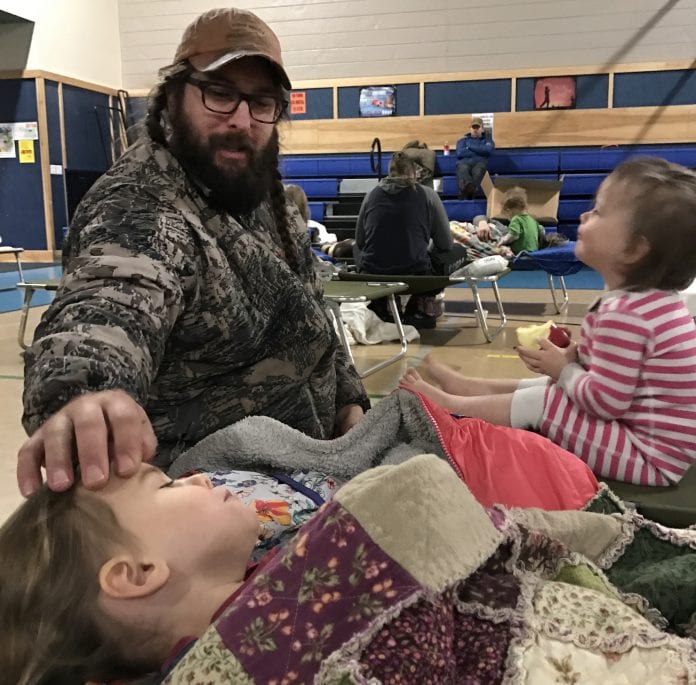
Sirens and phone alerts sounding a tsunami warning broke the silence, rattling nerves and interrupting an otherwise quiet Tuesday morning.
The sirens wailed in Cordova, as in and other coastal communities stretched thousands of miles along Alaska’s more southern coastline, as a 7.9 earthquake struck at 12:32 a.m. on Jan. 23 in the Gulf of Alaska, 170 miles southeast of Kodiak.
In Cordova, amidst the sirens and uncertainty, one man frantically searched for a sturdy container for his son’s gecko, while another packed beer into a grocery bag.
“I was running around with this dang lizard in a coffee mug looking for something better to put it in,” Joshua Donaldson said in a post on Facebook.
Donaldson’s six-year-old son, Brody, was insistent on quickly evacuating the family pets, even asking Donaldson to save his gecko’s mealworms.
“I didn’t know what to put him in, so I grabbed a coffee mug and put him in there,” Donaldson said, eventually transferring Lizzie, the pet gecko, into an old goldfish container. “I was just trying (to) sooth him, comfort him. (Brody) seemed to be more concerned about us, his pets and his family.”
Brody was at the door, dressed in a florescent yellow shirt, in under five minutes, waiting eagerly to evacuate to Ski Hill Road.
“When the sirens went out, that’s what really freaked him out,” Donaldson said. “He kind of came up with his own evacuation plan. He was more prepared than I was,” he added laughing.
Meanwhile at the incident command center at the Cordova Center, Joanie Behrends was gathering and relaying information to the public.
Shelly Kocan and her family slept through the earthquake and didn’t receive any tsunami alerts on their phones, but when Kocan woke up briefly around 1 a.m. she noticed a missed call from a friend.
She called back and was soon aware of the tsunami warning.
Immediately, Kocan and her husband gathered their daughters and collected blankets and snacks, making their way to Mt. Eccles Elementary School, a designated shelter in town, where they received more information.
Principle Gayle Groff and Superintendent Alex Russin relayed information from Behrends to the roughly 120 people who sought shelter at the school.
“People worked together until we found out we were safe,” Chief of Police Mike Hicks said. It was about as real as it could get,” he said, noting that disaster training aided in the effective communication.
According to Hicks, 60 to 70 people took shelter in the Little Chapel, including those in the hospital who used the chapel as their evacuation site.
The Cordova Community Baptist Church, Ski Hill Road and Sunnyside Drive were also used as evacuation sites and routes during the warning.
Wendy A. Ranney, owner of Orca Adventure Lodge, took to Facebook to share updates about her businesses status which rests along the coast at the end of New England Cannery Road.
“We are monitoring bouys and have not evacuated, but are safe and monitoring tsunami stations,” she wrote on her Facebook page at 2:24 a.m., around the time that the first wave was projected to hit Cordova. “Eight people at Orca all accounted for currently.”
The tsunami warning was lifted around 3:40 a.m.
“My head was full of what if’s,” Ranney said. “What if we were in the middle of the season and there were hundreds of people here instead of eight? How far up the mountain should we go? What about the folks that cannot climb mountains right now…myself included? Lots to think about this morning.”
Ranney receive many calls from people in town who knew they wouldn’t be able to hear the sirens.
“We watched the buoys in the sound to see what the water level was doing. One registered over a 30-foot wave,” she said.
Cordova has two tsunami sirens, one located at the end of Nicholoff Way and the other by the boat haul, near the Samson Tug & Barge Co. yard.
“We were getting reports after the fact that people weren’t hearing the sirens,” Hicks said. He called the manufacturer of the sirens. The police department is continuing to gather information about locations where the siren could not be heard.
Hicks noted that most coastal communities have numerous sirens, each costing around $30,000.
According to policer Lt. Tim Putney, Kodiak has 21 tsunami sirens, Valdez has nine, Homer has four, and the Seward area has seven, with one located in Moose Pass.
The two sirens located in Cordova were purchased through state funding. Hicks hopes to get another siren set up near 6.5 Mile.
During the warning, ambulance crews were sent to Whitshed Road, alerting people along the coast to evacuate before the first wave was expected to hit.
“People moved about safely; they didn’t panic,” Hicks said. “Many people were really well prepared, but there’s always room for improvement. We want to make it better the next time,” he said, noting issues with icy road conditions along Ski Hill Road.
All schools had a delayed start of 11 a.m., as talk of the earthquake and tsunami consumed conversation around town.
At The Powder House, their Tuesday specials featured a Tsunami Burger and drinks that were “shaken, not stirred”.
“I love The Powder House,” Ranney posted along with a photo of the specials board. “This town is awesome.”
City Manager Alan Lanning said that there will be a community debriefing at North Star Theatre at 7 p.m. on Tuesday, Jan. 30.














